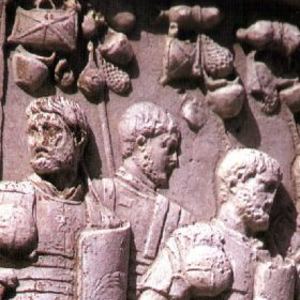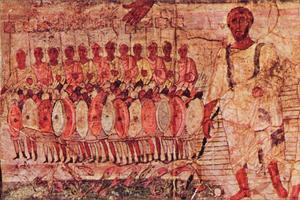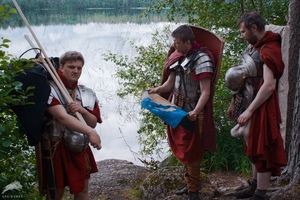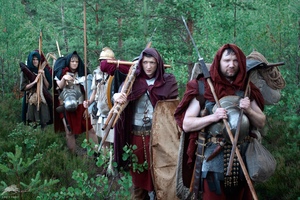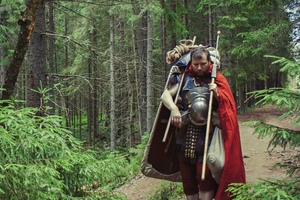Ancient Military Campaigns
The success of any ancient military campaign depended not only on the combat skills of the soldiers but also on their readiness for long marches. The duration and speed at which the legionaries could march, as well as their provisions and ammunition supply on enemy territory, often played a decisive role.
Roman military commanders, seeking to train and toughen their troops, made soldiers run and undertake long marches with heavy baggage on their shoulders. Such actions are attributed by ancient historians to Quintus Fabius Maximus, Publius Scipio Aemilianus, Quintus Metellus Numidicus, and other renowned generals. However, the greatest fame in training the army was acquired by Gaius Marius. His soldiers conducted marches with full gear, the weight of which was so great that, according to Plutarch, these warriors were called "Marius's mules."
Detailed information on how Roman military exercises were conducted can be found in the work of Vegetius, "De Re Militari," written in the late 4th or early 5th century. When writing this work, the author used numerous writings of his predecessors, from Cato the Elder to Tarruntius Paternus, which have not survived to the present day.
"The first training for recruits should be instruction in marching. During marches and in battle formation, the utmost care should be taken to ensure that all soldiers maintain proper alignment while moving. This can only be achieved if, through constant exercise, they learn to move quickly and in unison. The greatest danger always befalls a dispersed army that fails to maintain solid ranks. In five summer hours, a distance of 20 miles (30 km) can be covered by marching pace. At a quick march, which is faster, the same distance can be covered in the same amount of time, but 24 miles (35 km)."
Furthermore, Vegetius recommends conducting marches with full gear:
"You must also rigorously train young recruits to carry burdens of up to 60 pounds (about 20 kg) while marching. The necessity of carrying both provisions and weapons during difficult marches makes this imperative. Do not think it is difficult to carry such a weight once the skill is acquired; there is nothing that constant preliminary exercise does not render very light."
According to regulations established by Augustus and confirmed by Hadrian, military commanders were required to conduct exercises three times a month, during which:
"...infantry, fully armed with spears in hand, were to march 10 miles at a military pace and return to camp, with a portion of the distance to be covered by running."
The endurance acquired as a result of training the Roman soldiers was admirable. Cornelius Tacitus recounts that during the Civil War in 69 AD, six German legions under Vitellius covered 30 miles (40 km) in a day and then fought throughout the night. He also notes that the outcome of the battle would have been different if the soldiers had the opportunity to eat, warm up, and rest before the fight.
Campaign Equipment and Utensils
The camping utensils and equipment were no less important than the weapons used by legionaries in battle, as the duration of engagements in campaigns was much shorter compared to the time spent on movement and setting up camps. Various consumable materials, provisions, spare equipment components, and numerous items had to be carried, without which it would be impossible to arrange a camp.
Additional equipment items for a legionary needed during a campaign included:
- Furca (a pithfork)
- Flask
- Loculus (a small bag or pouch)
- Cups/mugs
- Fork
- Spoon
- Knives
- Situla (a bucket or pail)
- Patera (a shallow dish)
- Dolabra (a pickaxe)
- Plates
- Cassidil (a shallow basin)
- Penula (a frying pan)
On contubernium (a group of eight soldiers sharing a tent):
- Tent
- Cooking pot
- Tripod
- Frixorium (a portable stove)
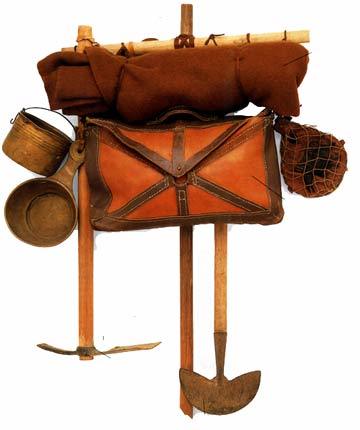 Campaign gear
Campaign gear
Reenactment
A military campaign in the style of living history is a true test of endurance, requiring careful preparation, quality equipment, and good physical fitness from the reenactor. The goal is to follow a route in full combat gear with camp and daily life equipment, aiming to recreate conditions that are as close as possible to an actual ancient campaign. It is important to plan ahead for provisions, fire-starting tools, spare clothing and footwear, and to bring a couple of cloak-penula for cold nights. The penula, in particular, will be most useful in case of unfavorable weather conditions. It is advisable to pre-plan the route of the campaign, mark the camp's location near a fresh water source, and pay special attention to the gathering of the furca (pitchfork) and securing the shield (it can be fastened with straps on the back or carried in hand). Successfully addressing these issues will ensure an optimal expenditure of energy and some level of comfort during the campaign.
